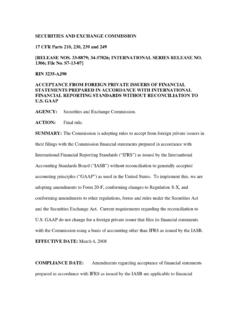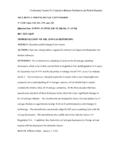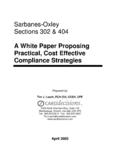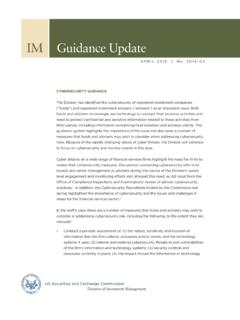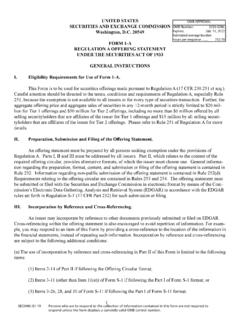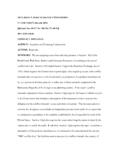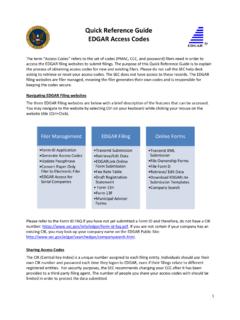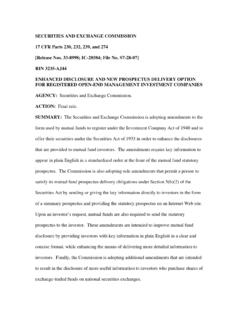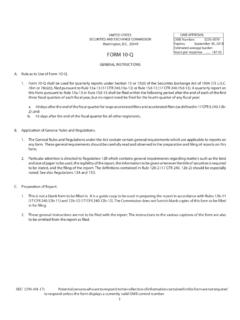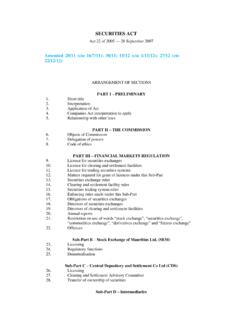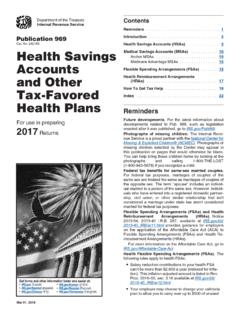Transcription of IM Guidance Update - SEC
1 IM Guidance Update December 2013 | No. 2013-13 Guidance on the exemption for advisers to venture capital funds The Division of Investment Management (the Division ) receives inquiries regarding the application of the exemption from investment adviser registration available to an investment adviser that advises solely one or more venture capital funds as defined in Rule 203(l)-1 of the Advisers Act (the VC Exemption ).1 To qualify as a venture capital fund the fund must be a private fund 2 that represents to investors that it pursues a venture capital strategy; does not provide an investor with redemption rights other than in extraordinary circumstances; holds no more than 20% of the amount of the fund s aggregate capital contributions and uncalled capital commitments in non- qualifying investments 3 (excluding cash and certain short-term holdings ); does not borrow or otherwise incur leverage in excess of 15% of the fund s aggregate capital contributions and uncalled capital commitments, and then only on a short-term basis.
2 And is not registered under the Investment company Act of 1940 and has not elected to be treated as a business development The five scenarios below are illustrative of the inquiries the Division is receiving with respect to the VC Exemption. Each involves situations where advisers have asked whether the fund structures or actions described below would jeopardize their ability to rely on the VC Exemption. The Division s response follows each scenario. 1) Scenario: Venture capital funds frequently hold their portfolio company investments through an intermediate holding company . Recognizing this, the Commission stated that, for purposes of the definition of a qualifying portfolio company , a fund may disregard an intermediate holding company formed solely for tax, legal or regulatory reasons to hold the fund s investment in a qualifying portfolio company so long as such intermediate holding company is wholly owned by the Venture capital advisers may have multiple private funds participating in any given portfolio com pany investment.
3 For example, two venture capital funds with the same adviser (or advisers that are related persons 6) may each invest in the same portfolio com pany. They may do so through a single intermediate holding company that is not wholly owned by either of the funds, but rather is wholly owned by the two funds collectively. Advisers have asked whether the Commission s statement concerning US Securities and Exchange Commission Division of Investment Management im Guidance Update 2 intermediate holding companies being wholly owned by a venture capital fund means that venture capital funds with the same adviser (or advisers that are related persons) may not jointly own a single intermediate holding company to invest in a portfolio company if they wish to disregard such entity for VC Exemption purposes.
4 Response: The Division would not object if an intermediate holding company is wholly owned collectively by more than one venture capital fund advised by the same investment adviser (or its related persons). 2) Scenario: Venture capital funds may have investors with varying tax, legal or regula tory concerns that lead their advisers to structure the funds in a way that addresses these concerns. The adviser will often accommodate tax-exempt and investors by forming an alternative investment vehicle ( AIV ) that is separate from the venture capital fund and that will elect to be taxed as a corporation. The tax-exempt and investors invest directly into this AIV which is controlled and managed by the adviser or a related person and whose sole purpose is to invest in the venture capital fund.
5 Because the AIV does not invest in qualifying investments and would therefore technically be holding more than 20% of the amount of the fund s aggregated capital contributions and uncalled capital commit ments in non- qualifying investments, advisers using this structure have asked the Division whether this structure disqualifies them from relying on the VC Exemption. Response: The Division would not object if an adviser relying on the VC Exemption disregards AIVs when determining whether it can meet the requirements of the VC Exemption provided that the AIV is formed solely to address investors tax, legal or regulatory concerns and such AIV is not intended to circumvent the VC Exemp tion s general limitation on investing in other investment vehicles.
6 3) Scenario: During the fundraising process for a prospective venture capital fund, the fund s investment adviser may identify an investment opportunity in a qualifying portfolio company that the adviser would like the fund to invest in, but such fund is not yet able to make investments. Rather than potentially missing these invest ment opportunities because the fund is unable to make investments, the adviser may effect the purchase of such an investment and then transfer the securities of the investment to the venture capital fund (a Warehoused Investment ) upon the fund s closing. Advisers have asked whether this arrangement would be deemed a non- qualifying investment because the equity securities of the portfolio company would not be acquired directly from the qualifying portfolio company .
7 Response: The Division would not object to an adviser treating a Warehoused invest ment as if it were acquired directly from the qualifying portfolio company for pur poses of the definition of venture capital fund under Rule 203(l)-1 of the Advisers Act provided that: (i) the Warehoused Investment is initially acquired by the adviser im Guidance Update 3 (or a person wholly owned and controlled by the adviser) directly from a qualifying portfolio company solely for the purpose of acquiring the investment for a prospec tive venture capital fund that is actively fundraising; and (ii) the terms of the Ware housed Investment are fully disclosed to each investor in the venture capital fund prior to each investor committing to invest in the 4) Scenario: An adviser may establish a venture capital fund ( Main Fund ) and one or more private funds to invest in parallel with the Main Fund ( Side Funds ).
8 In certain cases the adviser will close the Main Fund and form a Side Fund(s) in the months that follow, possibly after the Main Fund has made one or more portfolio company investments. The constituent documents of the Main Fund and any Side Fund(s) ( , the private placement memorandum and limited partnership agreement) typi cally provide that, in the event the Main Fund has made portfolio company invest ments before any Side Fund(s) has closed, the portfolio company securities will be transferred to the Side Fund(s) so that each fund holds its pro rata share of portfo lio company securities as if each fund had made the investment on the same day on the same terms. Advisers have asked if the Main Fund transfers portfolio securities to a Side Fund as described above, whether this arrangement would be deemed a non- qualifying investment for the Side Fund because the equity securities of the portfolio company that are transferred to the Side Fund would be acquired from the Main Fund and not directly from the qualifying portfolio company .
9 Response: The Division would not object to an adviser treating the investment by the Side Fund as described above as if the Side Fund acquired the portfolio com pany securities directly from the qualifying portfolio company for purposes of the definition of venture capital fund under Rule 203(l)-1 of the Advisers Act so long as such transfer occurs within 12 months of the final closing of the Main Fund and the potential for this type of transfer is fully disclosed in the constituent documents of the Main Fund and any Side Fund(s).8 5) Scenario: As a venture capital fund reaches the end of its term, the adviser some times determines to wind up the remaining affairs of the fund by causing the remaining portfolio securities of the fund to be transferred into a liquidating trust for which the adviser or an affiliate serves as the liquidating trustee.
10 The possibility of a liquidating trust and its terms are disclosed in the venture capital fund s con stituent documents. The purpose of the liquidating trust is to act as a successor to the venture capital fund and liquidate the remaining assets of the fund. Advisers have asked if the liquidating trust obtains its securities from the venture capital fund itself and not directly from a qualifying portfolio company whether this arrangement would be deemed a non- qualifying investment. Response: The Division would not object to the use of a liquidating trust by an investment adviser under the circumstances described above while relying on the VC Exemption. im Guidance Update 4 endnotes 1 See generally Section 203(l) of the Investment Advisers Act of 1940 ( Advisers Act ).

